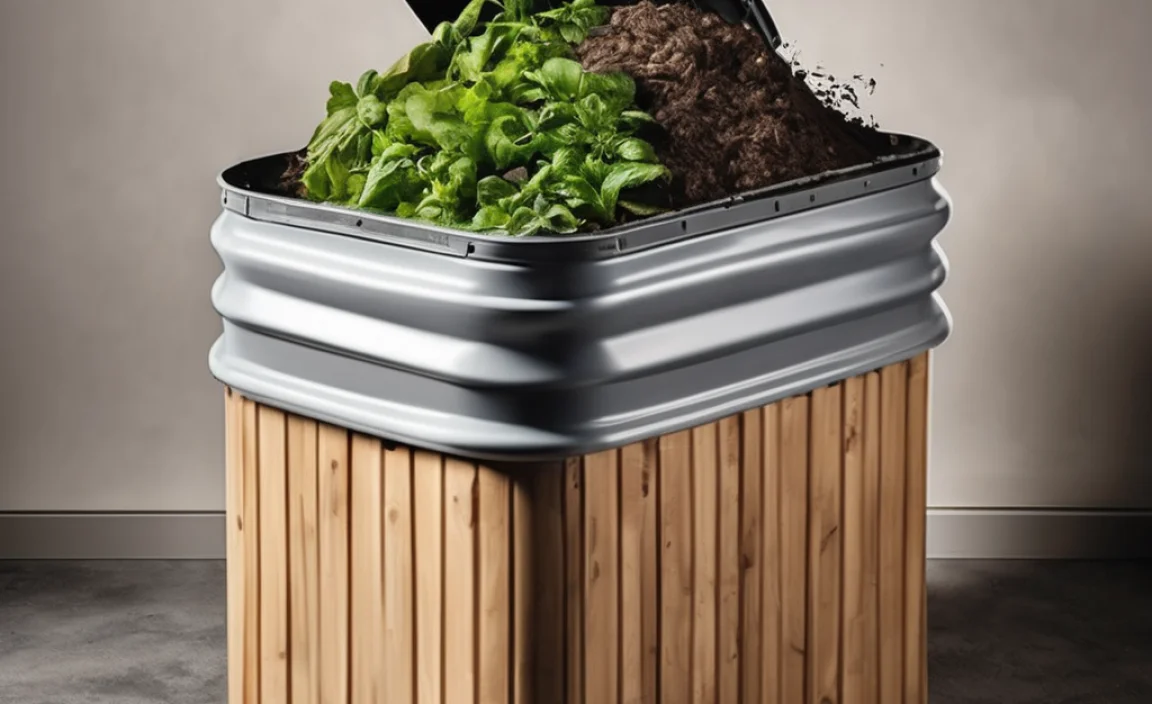Want to bring your dull enamel bathtub back to life? You can! Start by cleaning the tub with a mix of baking soda and dish soap. For tough stains, make a paste of baking soda and vinegar, let it sit, then scrub. Rinse well and dry. Your tub will look brighter and cleaner in no time!
Is your enamel bathtub looking a little sad? Don’t worry, you’re not alone! Many of us struggle with dull, stained tubs. It’s easy for them to lose their shine over time. But the good news is, you don’t need to spend a fortune on professional cleaners or a new tub. With a few simple steps and some common household items, you can bring back that sparkling clean look.
Ready to get started? We’ll walk you through everything you need to know, step by step. Let’s get that tub shining!
What You’ll Need

Before you start, gather these supplies. Having everything ready will make the job much easier. This list includes options for different levels of cleaning, so you can choose what works best for your tub’s condition.
- Baking soda
- Dish soap
- White vinegar
- Hydrogen peroxide
- Cream of tartar
- Soft cloths or sponges
- Spray bottle
- Old toothbrush
- Rubber gloves
- Eye protection
Step-by-Step Guide to a Sparkling Enamel Tub

Follow these steps to make your enamel bathtub shine. We’ll start with a basic cleaning and then move on to tackling tougher stains if needed.
Step 1: Rinse the Bathtub
Start by rinsing the entire bathtub with warm water. This will remove any loose dirt and debris. Make sure to get all the corners and edges.
Step 2: Apply Baking Soda and Dish Soap
In a small bowl, mix about 1/2 cup of baking soda with a few squirts of dish soap. The mixture should form a paste. Apply this paste to the entire surface of the bathtub. Use a soft cloth or sponge to spread it evenly.
Step 3: Scrub Gently
Gently scrub the bathtub with the cloth or sponge. Focus on areas that look particularly dirty or stained. Avoid using abrasive scrubbers, as they can scratch the enamel. For hard-to-reach areas, like around the drain or faucet, use an old toothbrush.
Step 4: Let it Sit
Let the baking soda and dish soap mixture sit on the bathtub surface for about 15-20 minutes. This will give it time to loosen any grime and stains.
Step 5: Rinse Thoroughly
Rinse the bathtub thoroughly with warm water. Make sure to remove all traces of the baking soda and dish soap mixture. You can use the showerhead or a bucket of water to rinse.
Step 6: Dry the Bathtub
Dry the bathtub with a clean, dry cloth. This will prevent water spots from forming and help to make the enamel shine. A microfiber cloth works great for this.
Step 7: Inspect and Repeat if Necessary
Take a look at your bathtub. If you see any remaining stains or dull spots, repeat the process. Sometimes, a second cleaning is needed to get the best results.
Tackling Stubborn Stains

If your bathtub has stubborn stains, here are a few extra methods you can try.
Method 1: Baking Soda and Vinegar Paste
Vinegar’s acidity can help break down tough stains. Here’s how to use it effectively:
- Make a paste of baking soda and white vinegar. Use about 1/4 cup of baking soda and enough vinegar to form a thick paste.
- Apply the paste to the stained areas.
- Let it sit for 30 minutes to an hour.
- Scrub gently with a soft cloth or sponge.
- Rinse thoroughly with warm water.
- Dry the bathtub.
Method 2: Hydrogen Peroxide and Cream of Tartar
This combination can be effective for lighter stains and discoloration:
- Mix hydrogen peroxide and cream of tartar to form a paste. Use about 2 parts hydrogen peroxide to 1 part cream of tartar.
- Apply the paste to the stained areas.
- Let it sit for 30 minutes to an hour.
- Scrub gently with a soft cloth or sponge.
- Rinse thoroughly with warm water.
- Dry the bathtub.
Method 3: Vinegar Soak
For widespread stains, a vinegar soak might be helpful:
- Fill a spray bottle with white vinegar.
- Spray the entire bathtub surface with vinegar.
- Let it sit for 2-3 hours.
- Scrub gently with a soft cloth or sponge.
- Rinse thoroughly with warm water.
- Dry the bathtub.
Important Safety Tips

Cleaning products, even natural ones, can cause irritation. Keep these safety tips in mind:
- Wear rubber gloves to protect your hands.
- Consider wearing eye protection, especially when using vinegar or hydrogen peroxide.
- Make sure the bathroom is well-ventilated. Open a window or turn on the exhaust fan.
- Never mix bleach with other cleaning products, as this can create dangerous fumes.
- Test any cleaning solution on a small, inconspicuous area of the bathtub first to make sure it doesn’t damage the enamel.
Maintaining Your Shiny Bathtub

Once you’ve got your bathtub shining, you’ll want to keep it that way. Here are a few tips for maintaining its cleanliness and shine:
- Rinse the bathtub after each use to remove soap scum and residue.
- Wipe down the bathtub with a clean cloth after each use to prevent water spots.
- Clean the bathtub regularly, at least once a week, to prevent buildup.
- Avoid using abrasive cleaners or scrubbers, as they can scratch the enamel.
- Consider using a squeegee after each shower to remove excess water from the walls and tub.
Choosing the Right Cleaning Products
With so many cleaning products on the market, it can be hard to know which ones are safe and effective for enamel bathtubs. Here’s a quick guide:
| Product | Pros | Cons | Best For |
|---|---|---|---|
| Baking Soda | Gentle, non-abrasive, natural | May not be effective on tough stains | General cleaning, light stains |
| Dish Soap | Readily available, effective for grease and grime | Can leave a residue if not rinsed well | Everyday cleaning |
| White Vinegar | Natural, effective for hard water stains and mildew | Strong odor | Hard water stains, mildew |
| Hydrogen Peroxide | Gentle bleaching action | Can be irritating to skin | Light stains, discoloration |
| Cream of Tartar | Mild abrasive, good for polishing | Not as effective on heavy stains | Polishing, light stains |
| Commercial Enamel Cleaners | Specifically formulated for enamel, often effective | Can be harsh, may contain chemicals | Tough stains, heavy buildup |
The Benefits of a Clean Bathtub
A clean, shiny bathtub isn’t just about aesthetics. It can also improve your overall bathroom experience. Here are a few benefits:
- A more relaxing and enjoyable bathing experience.
- A cleaner and healthier bathroom environment.
- Reduced risk of mold and mildew growth.
- Improved appearance of your bathroom.
- Increased sense of well-being.
DIY vs. Professional Cleaning
While DIY cleaning methods can be very effective, there are times when you might consider hiring a professional cleaning service. Here’s a comparison:
| Factor | DIY Cleaning | Professional Cleaning |
|---|---|---|
| Cost | Low | High |
| Convenience | Requires your time and effort | Convenient, saves you time |
| Effectiveness | Effective for most stains and buildup | Can handle very tough stains and buildup |
| Expertise | Requires some knowledge and skill | Professionals have experience and specialized equipment |
| Safety | Requires caution with cleaning products | Professionals are trained in safe handling of chemicals |
Consider professional cleaning if you have very tough stains, mold issues, or simply don’t have the time or desire to clean the bathtub yourself.
Common Mistakes to Avoid
Avoid these common mistakes to prevent damage and ensure a successful cleaning:
- Using abrasive scrubbers or cleaners that can scratch the enamel.
- Mixing bleach with other cleaning products.
- Not rinsing thoroughly, which can leave a residue.
- Ignoring safety precautions, such as wearing gloves and eye protection.
- Letting cleaning solutions sit for too long, which can damage the enamel.
When to Consider Refinishing or Replacing
If your bathtub has significant damage, such as chips, cracks, or severe rust, cleaning may not be enough. Here’s when to consider refinishing or replacing the bathtub:
- Extensive Damage: If the enamel is severely chipped or cracked, refinishing or replacing may be necessary to prevent further damage and leaks.
- Severe Rust: If rust is widespread and deep, it can be difficult to remove and may compromise the integrity of the bathtub.
- Unsightly Appearance: If the bathtub is severely stained or discolored and cannot be cleaned, refinishing or replacing can improve the appearance of your bathroom.
- Cost-Effectiveness: Compare the cost of refinishing versus replacing. In some cases, replacing the bathtub may be more cost-effective in the long run.
Refinishing involves applying a new coating to the bathtub surface. This can be a good option if the bathtub is structurally sound but has cosmetic damage. Replacing the bathtub involves removing the old tub and installing a new one. This is a more expensive option but may be necessary if the bathtub is severely damaged or outdated.
Eco-Friendly Cleaning Options
If you’re looking for eco-friendly ways to clean your enamel bathtub, here are a few options:
- Baking Soda and Vinegar: This is a classic combination that is effective for cleaning and deodorizing.
- Lemon Juice: Lemon juice is a natural acid that can help remove stains and hard water deposits.
- Borax: Borax is a natural mineral that can be used as a cleaning agent and disinfectant.
- Essential Oils: Adding a few drops of essential oils, such as tea tree or lavender, can provide a pleasant scent and antibacterial properties.
Always dilute essential oils before using them on surfaces, and test in an inconspicuous area first.
Using these natural cleaning options can help reduce your environmental impact and create a healthier home.
Troubleshooting Common Problems
Here are some solutions to common problems you might encounter while cleaning your enamel bathtub:
| Problem | Possible Solution |
|---|---|
| Stains won’t come off | Try a paste of baking soda and vinegar, let it sit longer, then scrub. |
| Residue after cleaning | Rinse the bathtub more thoroughly with warm water. |
| Scratches on the enamel | Avoid using abrasive scrubbers or cleaners. Use a soft cloth or sponge. |
| Lingering odors | Clean the drain and overflow drain. Use a mixture of baking soda and vinegar to deodorize. |
| Mold and mildew | Use a solution of vinegar and water to kill mold and mildew. Ensure proper ventilation. |
FAQ: Making Your Enamel Bathtub Shine
Q: Can I use bleach on my enamel bathtub?
A: Yes, you can use diluted bleach on an enamel bathtub, but it’s best to avoid it if possible. Bleach can be harsh and may damage the enamel over time. If you do use bleach, make sure to dilute it properly and rinse thoroughly.
Q: How often should I clean my enamel bathtub?
A: You should clean your enamel bathtub at least once a week to prevent buildup and stains. Rinse and wipe down the tub after each use to keep it looking its best.
Q: What’s the best way to remove hard water stains from my bathtub?
A: White vinegar is excellent for removing hard water stains. Spray the affected areas with vinegar, let it sit for a few hours, then scrub and rinse.
Q: Can I use a magic eraser on my enamel bathtub?
A: Magic erasers can be effective for cleaning, but they are slightly abrasive. Use them sparingly and test in an inconspicuous area first to avoid scratching the enamel.
Q: How do I prevent soap scum buildup in my bathtub?
A: Rinse the bathtub after each use to remove soap scum. Use liquid soap instead of bar soap, as bar soap tends to create more scum. You can also wipe down the tub with a squeegee after each shower.
Q: Is it safe to use commercial tub and tile cleaners on my enamel bathtub?
A: Yes, but choose cleaners specifically designed for enamel surfaces. Avoid abrasive cleaners and always follow the manufacturer’s instructions. Test in a small area first.
Q: What should I do if my bathtub has rust stains?
A: For rust stains, try a paste of lemon juice and salt. Apply the paste to the rust stains, let it sit for a few hours, then scrub and rinse. For stubborn rust, you might need a commercial rust remover.
Conclusion
So, there you have it! Making your dull enamel bathtub shine doesn’t have to be a daunting task. With these simple steps and a few common household items, you can transform your tub into a sparkling oasis. Remember to always prioritize safety, test cleaning solutions in a small area first, and maintain your tub regularly to keep it looking its best. Now, go ahead and give your bathtub the TLC it deserves. You’ll be amazed at the difference it makes!


